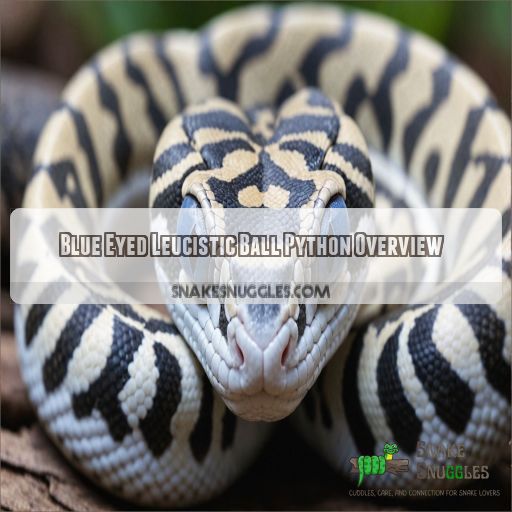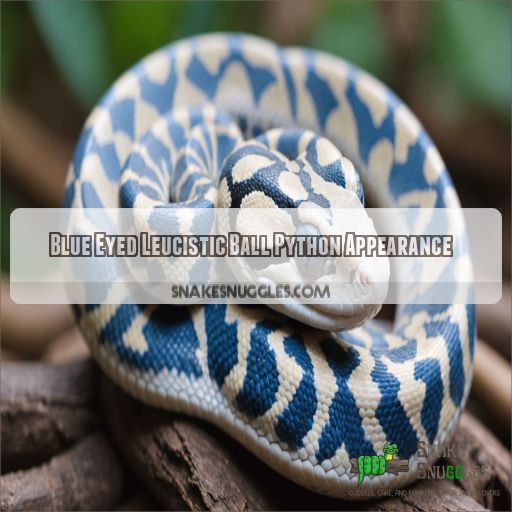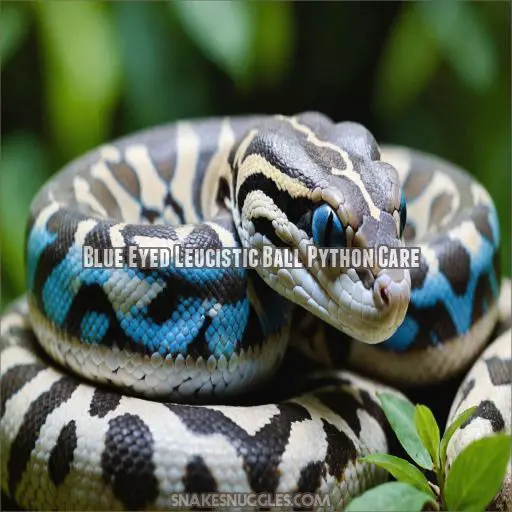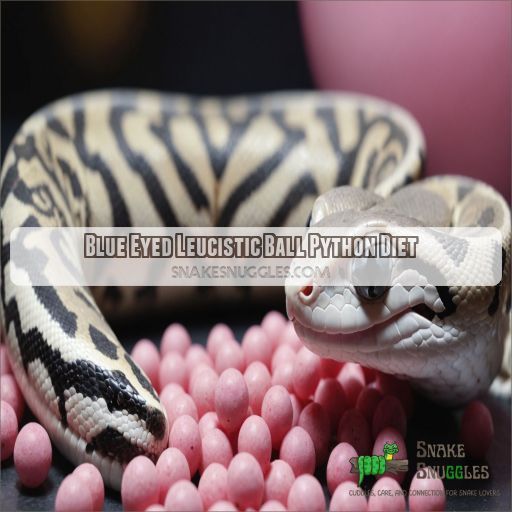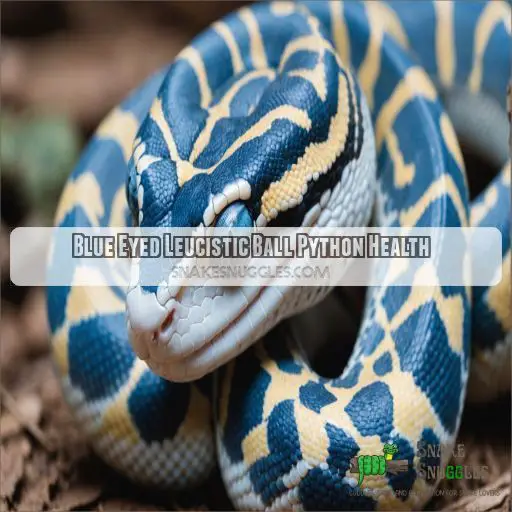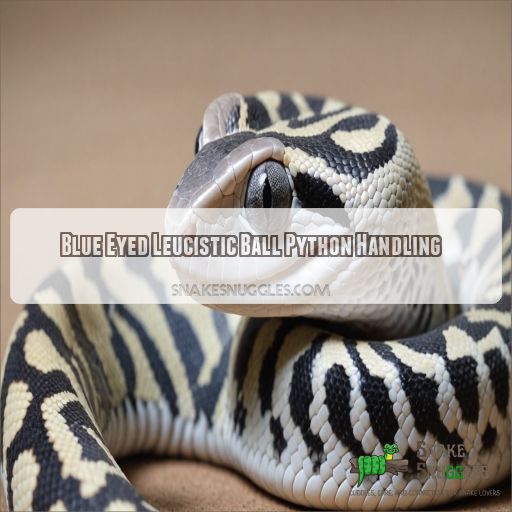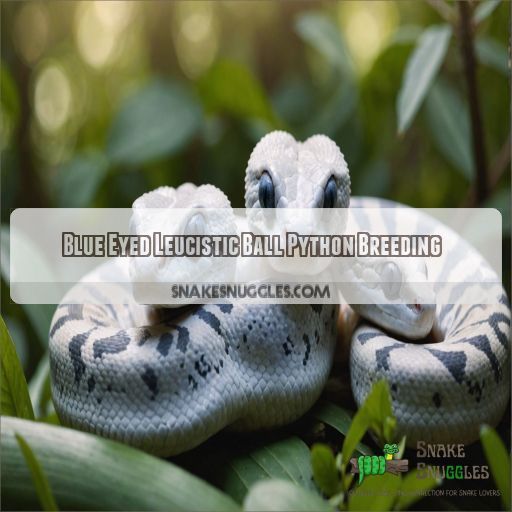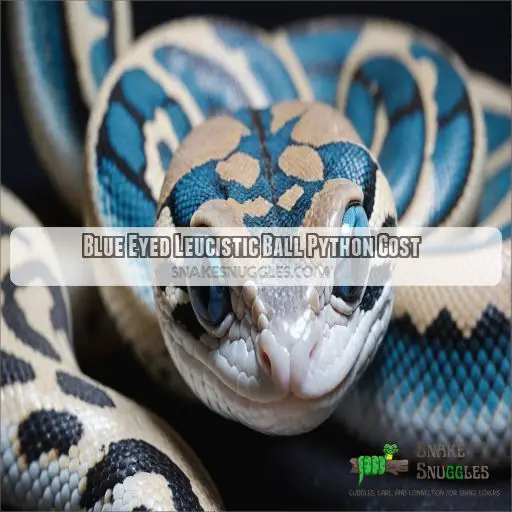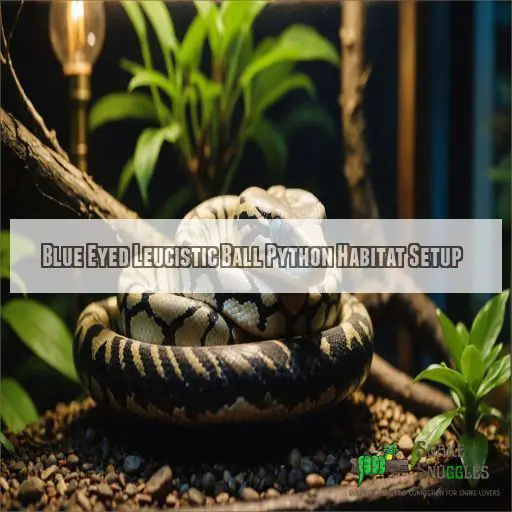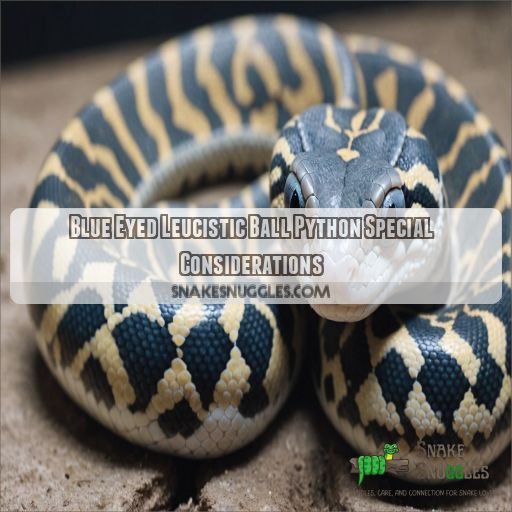This site is supported by our readers. We may earn a commission, at no cost to you, if you purchase through links.
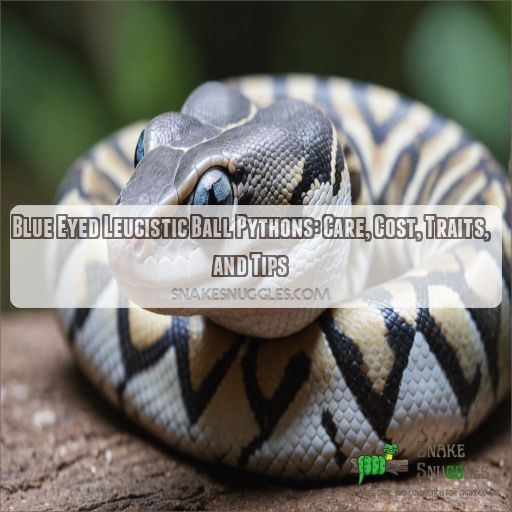 Discovering blue-eyed leucistic ball pythons is like finding a diamond in the rough of the reptile world.
Discovering blue-eyed leucistic ball pythons is like finding a diamond in the rough of the reptile world.
These stunning snakes boast milky white scales and striking blue eyes, making them an eye-popping addition to any collection.
Though they’re not found in the wild, their charm is all natural, resulting from selective breeding.
Caring for them requires a keen eye for detail: from providing the right enclosure, diet, and humidity to handling them with gentle patience.
They may be a handful, but their rarity makes any effort worthwhile.
Ever wondered about their quirky personalities or their breeding secrets?
Read on!
Table Of Contents
- Key Takeaways
- Blue Eyed Leucistic Ball Python Overview
- Blue Eyed Leucistic Ball Python Appearance
- Blue Eyed Leucistic Ball Python Care
- Blue Eyed Leucistic Ball Python Diet
- Blue Eyed Leucistic Ball Python Health
- Blue Eyed Leucistic Ball Python Handling
- Blue Eyed Leucistic Ball Python Breeding
- Blue Eyed Leucistic Ball Python Cost
- Blue Eyed Leucistic Ball Python Habitat Setup
- Blue Eyed Leucistic Ball Python Special Considerations
- Frequently Asked Questions (FAQs)
- How to take care of a blue eyed leucistic ball python?
- What are some facts about blue eyed leucistic ball pythons?
- How to produce blue eyed leucistic ball in python?
- Are blue-eyed leucistic ball pythons poisonous?
- How does the BLUE affect environmental awareness?
- Can you train a BLUE for specific behaviors?
- What social behavior do BLUES exhibit with other snakes?
- Are there famous BLUE specimens known in the community?
- How do BLUES react to music or noise?
- Conclusion
Key Takeaways
- Creating the Perfect Home: You’re not building Hogwarts, but your snake’s cozy palace needs attention to detail. Think about temperature gradients, humidity, and hiding places. Remember, a happy snake is one with the perfect mini spa experience!
- Dietary Needs: Your blue-eyed buddy thrives on a rodent diet. Mixing up prey sizes and types adds spice to their diet, but aim for consistency. Just make sure you’re not suddenly serving sushi when they expect pizza!
- Handling with Care: Handling your slithery friend is like dancing a waltz – approach with patience and calmness. Let them lead the rhythm. With gentle handling, you’ll build trust and avoid those snappy moments.
- Breeding Blues: Dreaming of baby blues? Breeding these gems is like solving a complex puzzle. Achieving that mystical blue-eyed look requires a keen eye for genetics, and some guesswork, since only 25% of hatchlings might have those enchanting peepers.
Blue Eyed Leucistic Ball Python Overview
When you’re exploring morph ball pythons, you’ll discover that the Blue-Eyed Leucistic is one of the most striking, bred through selective genetic combinations. You won’t find them in the wild, but their milky white scales and stunning blue eyes make them a real collector’s gem – like the rare Pokmon card of the snake world!
What is a Morph Ball Python?
Imagine a world of endless genetic possibilities with snake morphs like the Banana Mimosa Ball Python!
A morph ball python, including the blue-eyed leucistic variety, is like nature’s art piece.
These stunning creatures result from genetic mutations that create unique color variations.
Thanks to breeding techniques and ethical considerations, you can now enjoy the wonder of morph ball pythons—ethics and mastery combined in one slithering package!
What Are BEL Pythons and How Are They Created?
Blue-Eyed Leucistic (BEL) Ball Pythons are a unique morph created through selective breeding. This phenotype combines genes from five different morphs over three generations. Achieving a BEL hatchling is challenging, with only a 25% chance of success even from a breeding pair. The process requires patience, expertise, and a keen eye for genetics.
- Selective breeding techniques
- Combining multiple morph genes
- Challenging 25% hatch rate
- Requires genetic expertise
What Makes Blue Eyed Leucistic Ball Pythons Special?
What makes Blue-Eyed Leucistic Ball Pythons special is their striking appearance, a visual masterpiece of milky white scales and mesmerizing blue eyes. Thanks to unique ball python morphology and selective snake genetics, these rare beauties stand out. Its like discovering a unicorn, but in snake form! Their rarity and charm make them highly sought-after in the reptile world.
Are BEL Ball Pythons Found in the Wild?
While Blue-Eyed Leucistic Ball Pythons are stunning, don’t expect to stumble across them in the wild! These beauties are unique to captivity, the result of selective breeding. Here’s the scoop:
- Wild Ball Pythons – sport natural patterns.
- Morph Origins – all about controlled environments.
- Ethical Breeding – essential for rare morphs.
- Genetic Mutations – crafted by reptile enthusiasts.
Blue Eyed Leucistic Ball Python Appearance
Get ready to explore the fascinating appearance of Blue-Eyed Leucistic Ball Pythons, where their stunning milky white scales and striking blue eyes make them the supermodels of the snake world. Despite their impressive looks, they maintain a friendly demeanor, proving that ball pythons aren’t just about the fashion, but also about the charm.
Colors and Patterns
If you’re interested in the striking appearance of Blue-Eyed Leucistic Ball Pythons, you’ll be delighted to discover the vibrant color variations and intricate patterns that make these snakes true showstoppers. From creamy white scales to piercing blue eyes, each BEL python is a unique work of art. Prepare to be mesmerized!
| Color Variation | Pattern Genetics | Morph Combinations | Visual Appeal | Breeding Goals |
|---|---|---|---|---|
| Milky White | Leucistic | 5 Morphs | Piercing Blue | Consistent Traits |
| Ivory | Recessive | 3 Generations | Striking | Rare Phenotypes |
| Cream | Co-Dominant | Selective Breeding | Captivating | Unique Patterns |
| Albino | Polygenic | Unpredictable | Mesmerizing | Desirable Traits |
| Translucent | Incomplete | Challenging | Breathtaking | Reliable Reproduction |
Size and Growth Rate
Blue-Eyed Leucistic Ball Pythons don’t grow overnight! Hatchlings start at 10-17 inches, usually reaching 4-5 feet as adults. Their growth stages, including juvenile development, vary with diet and care. Proper ball python care helps steady growth. A spacious ball python enclosure and balanced diet impact the growth rate directly, illustrating that they’ve got big plans for a little snake!
Lifespan
As your Blue-Eyed Leucistic Ball Python grows, let’s chat about lifespan. On average, they live 20-30 years, giving you a long-term scaly companion.
- Diet Impact: Good nutrition boosts longevity; keep their diet varied.
- Health Concerns: Watch for common issues like respiratory infections.
- Breeding Influence: Breeding doesn’t shorten lifespan.
- Snakes: They’re not ticking time bombs, so enjoy!
Blue Eyed Leucistic Ball Python Care
Creating the perfect home for your Blue-Eyed Lucy doesn’t require Hogwarts-level magic, but understanding their needs is really important. Make sure you know the basics about enclosure size, temperature gradient, humidity levels, and substrate options to keep your enchanting snake comfortable and thriving.
Enclosure Size and Type
A spacious and secure enclosure, such as a best snake enclosure, is crucial for your Blue-Eyed Leucistic Ball Python’s growth and comfort. The size of your Blue-Eyed Leucistic Ball Python’s enclosure is really important for its well-being. Hatchlings and juveniles thrive in 15-20 gallon tanks, while adults do best in 40 gallon tanks. PVC enclosures are ideal for retaining heat and humidity, while shallow tubs work well in rack systems. Choose a substrate that holds moisture, like coconut fiber or cypress mulch.
Temperature Gradient and Lighting
Three basic needs for good ball python care? Heating, lighting, and basking, of course! Imagine this: your Blue-Eyed Leucistic lounging under a sunny spotlight on its favorite rock. A thermostat controls temps 84-89F on the warm side, up to 94F for basking, and cooler temps (75-80F) for balance. As a ball python enthusiast, you’re providing a 5-star habitat!
Humidity Levels and Water
You’ve got the temperature right, now consider humidity, the invisible lifeline for your Blue-Eyed Lucy! Keep things cozy with a water bowl, mist occasionally, and watch for condensation without creating a rainforest. Regular water changes make sure it’s fresh. Imagine if your shower quit mid-shampoo! Follow this ball python care sheet, which emphasizes the importance of a temperature gradient of 76-92°F and humidity around 55-60% using a hygrometer and humid hide boxes for optimal ball python housing; your snake’s shedding will thank you!
Substrate Options
You’ve nailed humidity, now it’s time to think "snake carpet."
Choose a substrate for your Blue-Eyed Lucy that hugs moisture like a toddler clings to their teddy bear—perfect for humidity control!
Options are soil, coconut fiber, cypress mulch, or sheet paper.
Consider safety concerns and your cleaning routine.
Compare costs and find an option that fits your ball python care preferences.
Blue Eyed Leucistic Ball Python Diet
As a blue-eyed leucistic ball python owner, you’ll be pleased to know that these stunning snakes thrive on a varied rodent diet. While rats are the staple, offering a mix of prey sizes and types can provide nutritional benefits and enrich your snake’s life.
Rodent Diet and Prey Options
You’ve got your Blue-Eyed Leucistic Ball Python’s home all set; now let’s talk grub! These beauties thrive on a rodent diet, with rats being their main squeeze.
- Nutritional Variety: Rats are the go-to, but mixing things up can offer enrichment benefits.
- Hunger Strikes: Introducing new foods might cause them to refuse eating.
- Live vs. Frozen: Depending on comfort, choose live or frozen prey.
Prey Size and Feeding Schedule
Understanding the right prey size and feeding schedule is key to a happy Blue-Eyed Lucy. Young pythons prefer smaller, frequent meals, while adults opt for larger, spaced-out feasts.
| Age | Prey Size | Feeding Frequency |
|---|---|---|
| Hatchling | Fuzzy mice | Every 5-7 days |
| Juvenile | Small rats | Weekly |
| Adult | Medium-Large rats | Every 10-14 days |
Because, really, who enjoys a hangry python?
Live Vs. Frozen/Thawed Prey
Choosing between live and frozen/thawed prey requires balancing nutritional value, prey acceptance, and handling safety.
Live prey may seem more appetizing, yet opting for frozen/thawed could save some drama and fingers!
Consider the cost comparison; frozen options often win the price battle.
Plus, ethical considerations and python care should tip the scales, keeping your ball python breeding smoothly and responsibly.
Potential for Hunger Strikes
Introducing new foods to your blue-eyed leucistic ball python can sometimes lead to a frustrating "hunger strike." Don’t worry – this is common behavior. To avoid it, stick to familiar prey, introduce new foods slowly, and be patient. With time and consistency, your snake will likely overcome its pickiness and resume eating regularly.
- Hunger strike triggers: Stress, new environments, unfamiliar prey
- Prey variety impact: Can cause feeding refusal
- Stress and feeding: Avoid handling after meals to prevent regurgitation
- New food introduction: Gradual, one item at a time
Blue Eyed Leucistic Ball Python Health
Keeping your Blue-Eyed Leucistic Ball Python healthy involves watching for common issues like respiratory infections or mites. Regular vet check-ups and staying alert to signs of stress or illness, like loss of appetite or wheezing, are all part of a snake owner’s job—think of it as the ultimate "pet detective" mission!
Common Health Issues
Just like us after a long Monday, Blue-Eyed Leucistic Ball Pythons can face stress-related ailments. Parasite infections, respiratory issues, shedding problems, and dietary deficiencies can sneak up on these beauties. Keeping an eye on their habitat and diet helps ward off pesky problems. It’s like telling your snoozing friend to stop skipping breakfast—vital for a healthy lifestyle!
Signs of Illness and Stress
Lethargy in your snake can be a sign its off its game. An appetite loss isn’t just "picky eating"; it’s waving a red flag. Encountering shedding issues or eye discharge? They’re like a blinking warning light. Changes in skin could suggest something’s amiss. Stay sharp, like Sherlock Holmes, and spot these signs early to help your snake thrive!
Veterinary Care and Check-Ups
Routine veterinary check-ups are essential for your blue-eyed leucistic ball python’s health. Your vet can spot potential issues early and provide preventative care, like parasite screening and treatment. Don’t hesitate to consult your vet if you notice any changes in your snake’s behavior or appearance – they’re your furry friend’s best ally in staying happy and healthy.
Blue Eyed Leucistic Ball Python Handling
When handling your Blue-Eyed Leucistic Ball Python, approach with patience and calmness to make sure a stress-free experience for both you and your snake. Remember, they’re more slippery than an overcooked spaghetti noodle; support their body and avoid sudden movements to prevent defensive bites and foster a bond over time.
Proper Handling Techniques
Handling your Blue-Eyed Lucy is like taming a gentle dragon. Approach calmly from the side, ensuring safe handling by sliding hands beneath. Support its body to reduce stress. Adjust holding positions to read snake behavior; this aids in bite prevention. Remember, every interaction is a dance of mutual trust.
- Approach from the side
- Support the body
- More trust, fewer bites
- Slow movements
Patience and Calmness
In snake handling, you’ll find patience and calmness are your best friends for stress reduction. Picture yourself as a soothing rock in a stormy sea. Blue-Eyed Leucistic Ball Pythons respond best to gentle, mindful movements. Bonding’s a dance; let your calm approach lead. They’re not mind readers, but they’ll feel your Zen vibes, building trust over time.
Avoiding Defensive Bites
Avoiding defensive bites is key when handling your blue-eyed leucistic ball python.
Approach calmly, move slowly, and avoid sudden movements.
Observe the snake’s body language. If it appears tense or coiled, back off and try again later.
Use gentle, confident handling to build trust over time.
Never punish or scold your snake for defensive behavior. It’s a natural response, not aggression.
Bonding With Your Snake
Building trust with your Blue-Eyed Lucy is like dancing a duet; start slow and let them lead. Use gentle handling and positive reinforcement for bonding. Socialization doesn’t mean coffee dates but varies enrichment activities. Talk to your snake – they mightn’t answer, but they’ll appreciate the effort. Your patience and care will cultivate a tight-knit relationship.
Blue Eyed Leucistic Ball Python Breeding
If you’re thinking about breeding Blue-Eyed Leucistic Ball Pythons, get ready for an exciting yet tricky adventure. Though you’ll need patience and a bit of luck due to genetic challenges, the chance to produce these rare beauties is well worth the challenge.
Genetic Considerations
In breeding Blue-Eyed Leucistic Ball Pythons, understanding genetic testing’s importance is key. Lineage verification helps guarantee ethical breeding, avoiding undesirable traits. Dive deeper into morph combinations, but don’t let complexity unravel your plans. Just remember, while juggling genes might be like playing snake charmer, it’s the thoughtful approach that helps maintain the snakes’ striking beauty and diversity.
Breeding Challenges and Success Rates
Breeding Blue-Eyed Leucistic Ball Pythons can be a real head-scratcher, even for seasoned reptile enthusiasts. These morphs require a delicate dance of genetic factors, carefully curated breeding pairs, and just the right incubation conditions. But with patience and an ethical approach, you might just hatch a little blue-eyed beauty. The odds are tricky, but the payoff can be oh-so-rewarding.
Potential for Producing BEL Pythons
Breeding Blue-Eyed Leucistic Ball Pythons is like crafting a fine-tuned puzzle where Genetic Factors and Morph Combinations hold the key. Success Rates hinge on understanding the lineage importance, though Breeding Challenges remain due to complexity. Patience is your best friend here; remember, even the best breeders don’t always hit the jackpot – but they do enjoy the ride!
Breeding for Specific Traits
When breeding Blue-Eyed Leucistic Ball Pythons, you’re entering a genetic maze. It’s about morph combinations and understanding recessive traits, but don’t lose your head! Ethical breeders focus on maintaining the snakes’ well-being.
- Genetic ethics: Prioritize health over aesthetic features.
- Selective breeding: Encourage desirable traits carefully.
- Morph combinations: Mix wisely for your desired lucy look.
Blue Eyed Leucistic Ball Python Cost
Buying a Blue-Eyed Leucistic Ball Python involves a bit more than just handing over cash; with prices starting around $700, it’s important to know what you’re paying for. You won’t find these beauties at your local pet store, so prepare to seek out reputable breeders or specialized exotic pet shops.
Price Range and Factors Affecting Cost
Expect to pay a premium for a Blue-Eyed Leucistic Ball Python, as their rarity drives up prices. Factors like age, genetics, and location can greatly impact the cost. Here’s a breakdown of typical pricing:
| Factor | Impact on Price |
|---|---|
| Age | Younger snakes cost less |
| Genetics | Proven breeding lines cost more |
| Location | Availability varies by region |
| Demand | High demand = higher prices |
| Supply | Limited supply = higher prices |
Where to Buy a Blue Eyed Leucistic Ball Python
You’re dreaming of owning a Blue-Eyed Leucistic Ball Python? Check out online marketplaces and local pet stores to compare prices. While some breeders offer ethical sourcing, others might need a nudge toward transparency. Remember, the reputable breeders are like pearls amidst pebbles – rare but worth the hunt. Keep your eyes peeled, and good luck!
Reputable Breeders and Sellers
Now that you know where to buy your Blue-Eyed Lucy, let’s talk about reputable breeders and sellers. Consider these avenues:
- Breeder Networks: Engage with those who prioritize breeding ethics.
- Online Marketplaces: Spot ethically sourced pythons.
- Local Resources: Visit exotic reptile expos.
- Forums: Join communities sharing firsthand experiences.
Blue Eyed Leucistic Ball Python Habitat Setup
Setting up a cozy habitat for your Blue-Eyed Leucistic Ball Python isn’t just a task; it’s an adventure in creating the perfect snake condo. Think temp gradients, humid hideouts, and a mini spa for your scaley friend, making sure your python feels like the king of its tiny kingdom.
Creating a Temperature Gradient
To create the perfect temperature gradient, start with a warm basking spot around 90-94°F. Use a reliable heating element like a ceramic heater or under-tank pad to maintain this toasty zone. On the opposite end, provide a cool hide around 75-80°F. This thermal gradient allows your blue-eyed lucy to thermoregulate comfortably.
Maintaining Humidity Levels
Keeping your Blue Eyed Leucistic Ball Python comfortable means fine-tuning humidity. You’ve got your temperature just right, now let’s water the proverbial garden. Use these tips:
- Substrate Choice: Go for coconut fiber or cypress mulch.
- Water Bowls: Place one on the warm side.
- Enclosure Ventilation: Adjust for airflow.
- Misting Frequency: Mist weekly—don’t mimic a monsoon!
Providing Hiding Places and Visual Stimulation
Enrich your Blue-Eyed Lucy’s life by creating cozy hiding spots and visually stimulating environments. Use natural materials like bark or rocks for DIY enrichment. Providing various hidden nooks gives your snake a sense of security, like your favorite reading spot. Think of visual stimulation benefits as adding spice to life, ensuring a happy, healthy python.
Water and Hydration Options
Your Blue-Eyed Lucy’s water needs aren’t rocket science, but it does need your attention. Regularly change its water to keep it fresh. Here’s your hydration checklist:
- Choose the right bowl size: Big enough for a good soak.
- Consider water source types: Tap or filtered?
- Monitor humidity control: Make sure it’s just right.
- Watch for dehydration signs: Dull skin, lethargy mean trouble!
Blue Eyed Leucistic Ball Python Special Considerations
While blue-eyed leucistic ball pythons are stunning, they may have some unique care requirements. And no, these gentle giants aren’t venomous – they’re simply mesmerizing reptiles that will captivate any snake enthusiast.
Potential for Special Care Requirements
As you fine-tune your Blue-Eyed Lucys habitat, awareness of its special care requirements is key. They thrive on stable dietary needs and health monitoring. Keep an eye out for signs of stress; their handling considerations are critical. Breeding concerns may require environmental adjustments. It’s like learning dance steps with a partner—you’ll eventually find the perfect rhythm!
Are Blue Eyed Leucistic Ball Pythons Poisonous?
You’ve gotten yourself a Blue-Eyed Leucistic Ball Python, but is it venomous? Rest easy, they’re not packing any venom. These snakes are more like the teddy bears of the reptile world—totally harmless. They might bite if startled, but there’s zero toxicity. So, cuddle away knowing your reptile buddy’s all charm and no venomous alarms!
Interesting Facts About Blue Eyed Leucistic Ball Pythons
You’ve mastered the care and cost of your Blue-Eyed Lucy. Now, feast your eyes on these fascinating tidbits:
- Descendant of genetic origins involving five morphs.
- Hilariously, even seasoned breeders find them an elusive catch—just like fishing for the Loch Ness Monster!
- Named for their dreamy blue eyes.
- Price trends have dropped since their $10,000 debut.
- Delight in care challenges, like maintaining perfect humidity!
Frequently Asked Questions (FAQs)
How to take care of a blue eyed leucistic ball python?
To care for your Blue-Eyed Lucy, imagine dancing the tango; maintain a cozy tank with balanced humidity and temperature. Feed them a rodent diet, and like any dance, handle them gently to build trust.
What are some facts about blue eyed leucistic ball pythons?
Blue Eyed Leucistic Ball Pythons, or "blue-eyed lucys," are rare beauties born from selective breeding, featuring piercing blue eyes and milky white scales. These coveted morphs, requiring special care, aren’t commonly found in pet stores.
How to produce blue eyed leucistic ball in python?
Think of breeding Blue-Eyed Leucistic Ball Pythons like achieving a magical combination. Pair Lesser or Mojave morphs together; cross your fingers, and hope for the best, as only 25% of hatchlings might reveal those mystical blue eyes.
Are blue-eyed leucistic ball pythons poisonous?
Blue-eyed leucistic ball pythons aren’t poisonous. Like all ball pythons, they’re non-venomous constrictors. They rely on squeezing their prey rather than venom to subdue it. So, you can relish their mesmerizing beauty without worry!
How does the BLUE affect environmental awareness?
Unfortunately, the question about "BLUE" affecting environmental awareness seems off-topic here. Perhaps there was a mix-up? Let’s focus on belly-whipping snakes! They sure don’t change climate knowledge, but they brighten habitats with style!
Can you train a BLUE for specific behaviors?
Training a BLUE to respond to basic cues, like handling and feeding times, is possible with patience and consistency. Think of it like teaching a shy dancer to waltz confidently—gentle, rhythmic guidance builds trust and cooperation.
What social behavior do BLUES exhibit with other snakes?
Blue-eyed leucistic ball pythons tend to be solitary snakes, preferring to keep to themselves. While they may tolerate the presence of other snakes, they generally don’t exhibit any strong social behaviors or form bonds with their fellow reptilian companions.
Are there famous BLUE specimens known in the community?
Famous Blue-Eyed Lucy pythons? It’s like spotting a celebrity at the grocery store! They’re rare, admired for stunning beauty, but none have reached superstar status in the reptile community yet. Your bungee jump into reptile royalty awaits!
How do BLUES react to music or noise?
Blue-Eyed Leucistic Ball Pythons, like most snakes, don’t have external ears, so rock concerts aren’t their jam. However, they can sense vibrations. It’s best to keep their environment calm to prevent stress-induced dancing!
Conclusion
Blue-eyed leucistic ball pythons are a mesmerizing morph that attracts reptile enthusiasts worldwide.
They have a striking appearance and unique care requirements.
These snakes are not for the faint of heart.
But for those willing to put in the effort, they offer a truly rewarding experience.
Whether you’re a seasoned breeder or a first-time owner, the allure of the blue-eyed leucistic ball python is undeniable.

